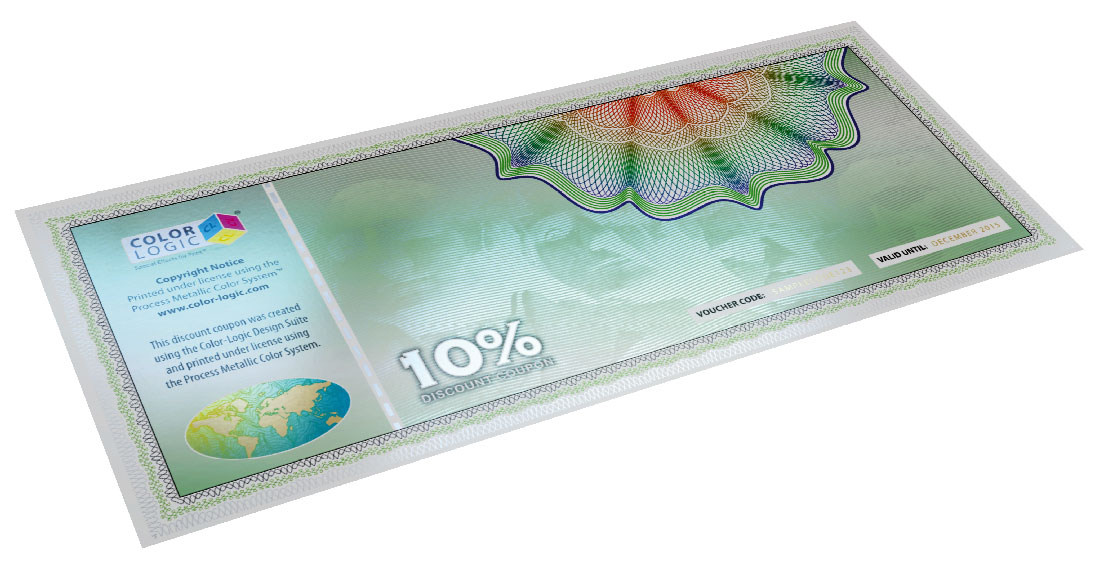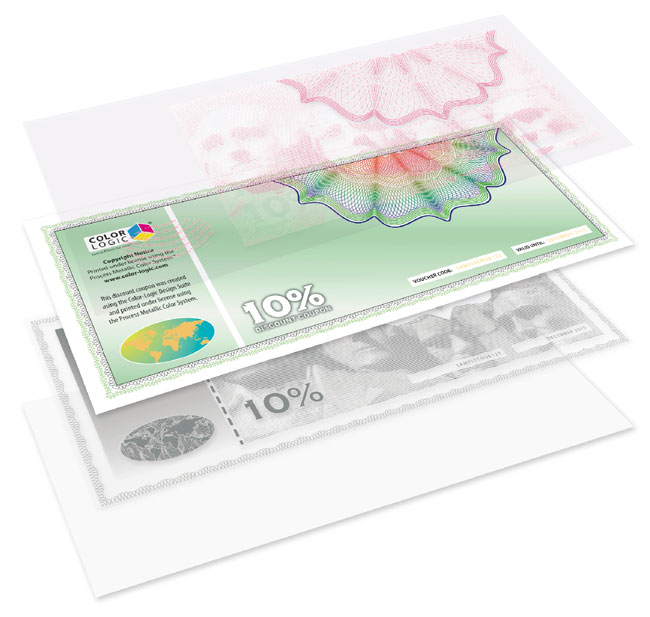
*** The information on this page may be downloaded in PDF format from our Whitepapers section ***
Counterfeiting goods is often made easier when consumer brands use spot colors to create their artwork. Using a spectrophotometer, a would-be counterfeiter can easily and accurately measure any nonmetallic color on a printed item. With the measurement in hand, all the counterfeiter then needs to do is scan the printed item and recreate the artwork. This is the way many branded products are easily copied.
The Color-Logic System™ provides a unique solution which enables any designer with the Color-Logic Design Suite and FX-Viewer™ to implement a diverse range of special effects as a first line of defense against counterfeiting. The basic Color-Logic effects may be visualized on the computer screen using FX-Viewer, before going out to proof or print.
Using the Color-Logic software, designers can incorporate dynamic effects that react to light as the printed piece is moved or rotated. Subtle watermarks can be embedded within metallic areas on a package design. These watermarks may be used as an almost subliminal logo branding in the background of a label or package. More advanced designers may use the Color-Logic software to create extremely complex security features such as colored and gradated metallic guilloches, or invisible ink separations generated from photographic images. Whether the graphic designer chooses to design overtly or covertly, the Color-Logic system can add shine and security to product packaging that is limited only by the designer’s creativity.
Counterfeiting goods is often made easier when consumer brands use spot colors to create their artwork. Using a spectrophotometer, a would-be counterfeiter can easily and accurately measure any nonmetallic color on a printed item. With the measurement in hand, all the counterfeiter then needs to do is scan the printed item and recreate the artwork. This is the way many branded products are easily copied.
The Color-Logic System™ provides a unique solution which enables any designer with the Color-Logic Design Suite and FX-Viewer™ to implement a diverse range of special effects as a first line of defense against counterfeiting. The basic Color-Logic effects may be visualized on the computer screen using FX-Viewer, before going out to proof or print.
Using the Color-Logic software, designers can incorporate dynamic effects that react to light as the printed piece is moved or rotated. Subtle watermarks can be embedded within metallic areas on a package design. These watermarks may be used as an almost subliminal logo branding in the background of a label or package. More advanced designers may use the Color-Logic software to create extremely complex security features such as colored and gradated metallic guilloches, or invisible ink separations generated from photographic images. Whether the graphic designer chooses to design overtly or covertly, the Color-Logic system can add shine and security to product packaging that is limited only by the designer’s creativity.
Solid Metallic Colors
Using metallic colors is an excellent way to add a relatively simple level of security to a design. The inherent nature of metallic inks makes photographing or color copying almost impossible, because light is reflected by the metallic particles in the ink, causing the appearance to change as the print is moved. This, in turn, makes accurately scanning or color copying a metallic ink virtually impossible.
Metallics, however, are more costly and require additional printing plates on the press. With the Color-Logic system, those limitations are dramatically reduced, since a fully chromatic palette of 250 lustrous metallic colors can be created inline using just one spot ink in addition to the primary colors used on press.
The Cellphone Sim Card design to the right shows how different pre-paid sim cards (which could be designed to show varying monetary value for each pre-pay card), can be identified by a unique metallic color. Added to this design was our Dimensional-FX technique for the dotted pattern in the background, which will change hue when the item is moved.
Using metallic colors is an excellent way to add a relatively simple level of security to a design. The inherent nature of metallic inks makes photographing or color copying almost impossible, because light is reflected by the metallic particles in the ink, causing the appearance to change as the print is moved. This, in turn, makes accurately scanning or color copying a metallic ink virtually impossible.
Metallics, however, are more costly and require additional printing plates on the press. With the Color-Logic system, those limitations are dramatically reduced, since a fully chromatic palette of 250 lustrous metallic colors can be created inline using just one spot ink in addition to the primary colors used on press.
The Cellphone Sim Card design to the right shows how different pre-paid sim cards (which could be designed to show varying monetary value for each pre-pay card), can be identified by a unique metallic color. Added to this design was our Dimensional-FX technique for the dotted pattern in the background, which will change hue when the item is moved.
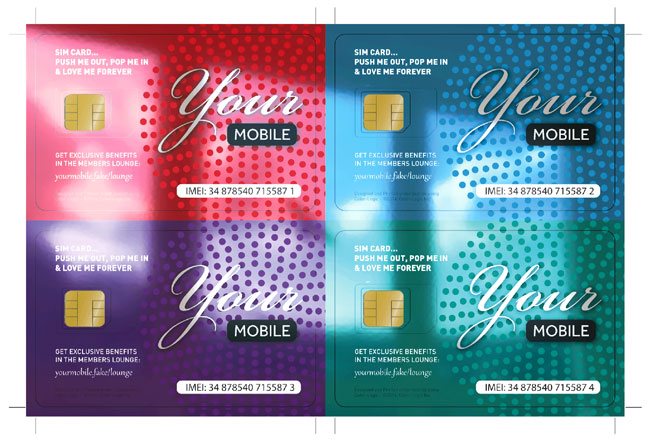
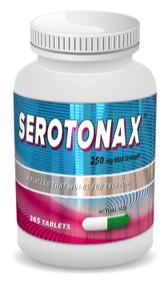
Gradation-FX™
Traditional spot metallic ink printing is limited to printing as either a solid or a tint. Blending a silver ink into a gold is virtually impossible, due to the opaque metallic pigments used in the inks. With the Color-Logic system, however, a graphic designer can vignette one metallic color into another, or can even vignette metallic hues into process colors. Vignettes of this sort are limited only by the imagination of the designer. Complex metallic gradients—blended into process colors and changing hue across a spectrum—can be integrated into the simplest or the most complex designs.
In the example shown to the left, integrated metallic gradients spiral out from the centre of the label. Because metallics reflect light, if this label was to be peeled off the bottle and measured with a spectrophotometer, the only reading you will get is an LAB value, which is of no use as you need to know what the Silver or White + CMYK ink values are that made up the design; unless you have the original artwork, it becomes increasingly difficult to counterfeit, depending on the level of complexity within the design.
Watermark-FX™
The watermark effect can be used to make a selected artwork area seem to vanish and reappear when placed within metallic areas on the design.
In the hair care label shown here, a Color-Logic watermark pattern was embedded in the background. This simple but very effective technique adds an extra dimensional layer to the design. When light bounces off the background, the embedded pattern appears and disappears as the print is moved.
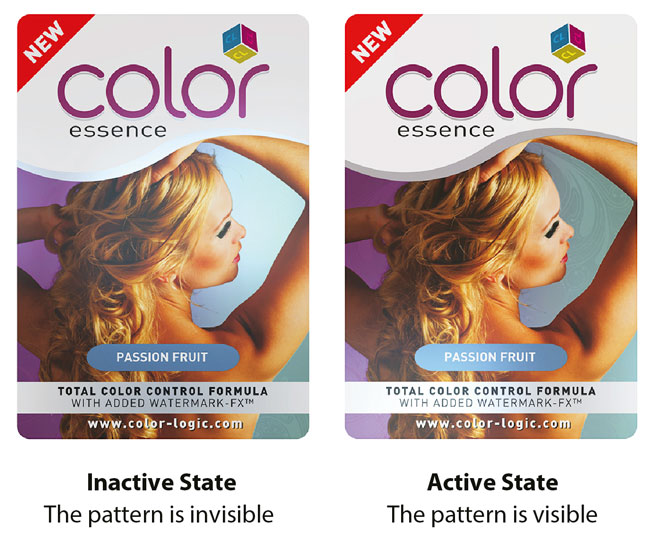
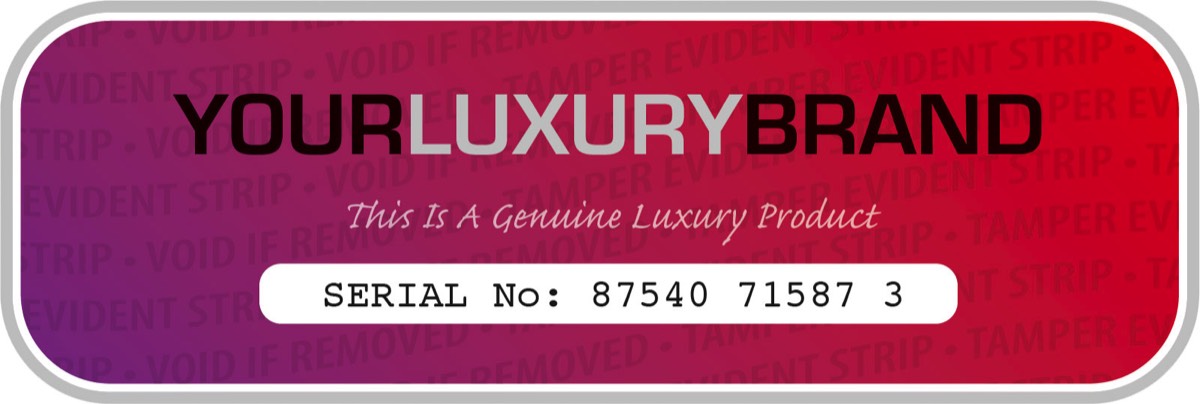
Watermark-FX™ PLUS
Add subliminal patterns, wording, logos, or even complex guilloches to artwork as a “barely visible” protective layer. This new and exciting special effect also can be used wherever a more subtle metallic effect is desired. Color-Logic Watermark-FX PLUS is particularly effective on highly reflective foil substrates.
In the Tamper Evident Sticker shown to the left, a subtle metallic watermark was added across the background gradient, creating a colored watermark that transitions from a light purple to a deep red.
Add subliminal patterns, wording, logos, or even complex guilloches to artwork as a “barely visible” protective layer. This new and exciting special effect also can be used wherever a more subtle metallic effect is desired. Color-Logic Watermark-FX PLUS is particularly effective on highly reflective foil substrates.
In the Tamper Evident Sticker shown to the left, a subtle metallic watermark was added across the background gradient, creating a colored watermark that transitions from a light purple to a deep red.
Dimensional-FX™
Dimensional-FX enables the graphic designer to make a selected artwork area appear to change color and dimension, from a lighter to a darker hue, as light reflects from the design. This feature provides an additional level of security within a visually stunning design. Color-Logic Dimensional-FX also can be used to place minute patterns in the background of packaging, allowing the designerl to create complex, light changing patterns without detracting the viewer’s focal point from the actual product.
In the mobile phone Box shown here, a minute pattern was embedded in the background of a design printed on a foil substrate using white ink. The pattern was printed with white ink, creating a light changing pattern that not only acts as a simple added security feature, but brightens the package design because of the way the pattern interacts with light. The effect ensures the package stands out on the shelf while deterring counterfeiters.
Dimensional-FX enables the graphic designer to make a selected artwork area appear to change color and dimension, from a lighter to a darker hue, as light reflects from the design. This feature provides an additional level of security within a visually stunning design. Color-Logic Dimensional-FX also can be used to place minute patterns in the background of packaging, allowing the designerl to create complex, light changing patterns without detracting the viewer’s focal point from the actual product.
In the mobile phone Box shown here, a minute pattern was embedded in the background of a design printed on a foil substrate using white ink. The pattern was printed with white ink, creating a light changing pattern that not only acts as a simple added security feature, but brightens the package design because of the way the pattern interacts with light. The effect ensures the package stands out on the shelf while deterring counterfeiters.
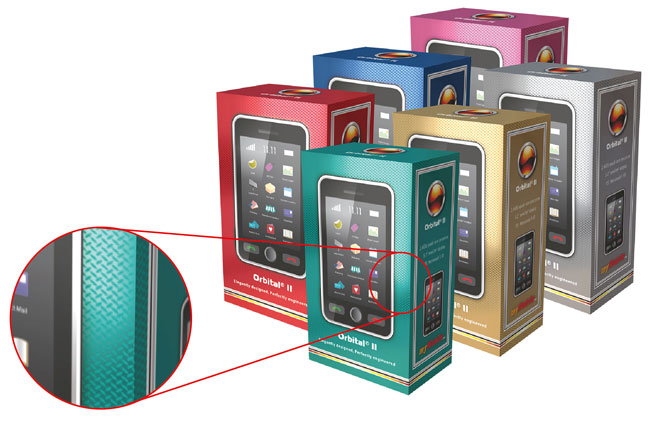
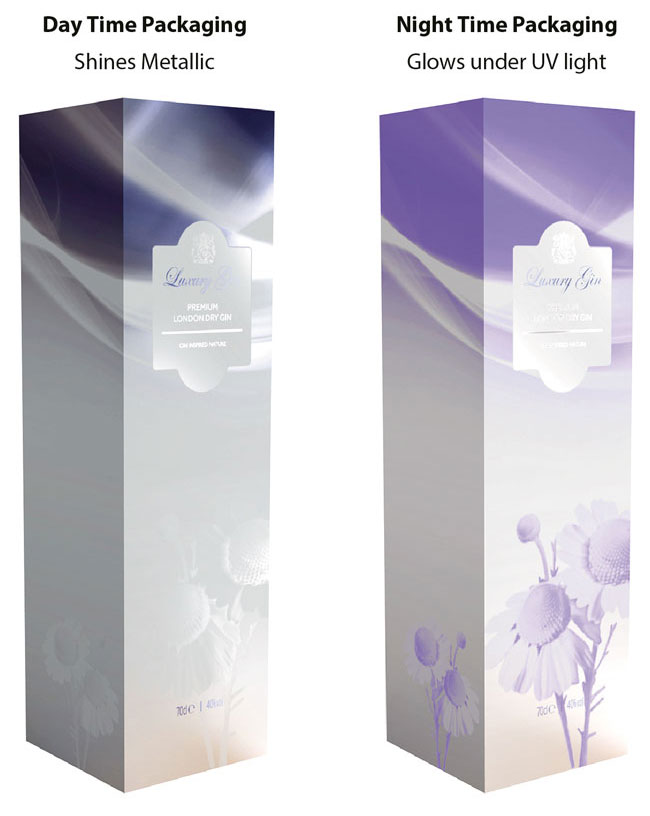
Image-FX™
Image-FX is a photorealistic image separation algorithm that analyzes images and calculates the required metallic effect for the different tonal regions of the image. This plug-in for Adobe Photoshop CC and higher automatically creates an effect printing plate for use with a metallic silver ink. If printing is to be done using metallic substrate, the effect printing plate can manipulated to output for white ink printing. This automated process eliminates the time consuming, trial and error method of integrating metallics into an image and only places metallic ink where it is required, using an advanced algorithm which also acts as an ink reduction tool.
The luxury packaging on the left above was created using a complex white ink mask, generated using the Color-Logic Image-FX plug-in. The package on the right was printed using the same plate to apply light-reactive ink which glows under ultraviolet light. This permits the elegant box package to retain its esthetics during day and night.
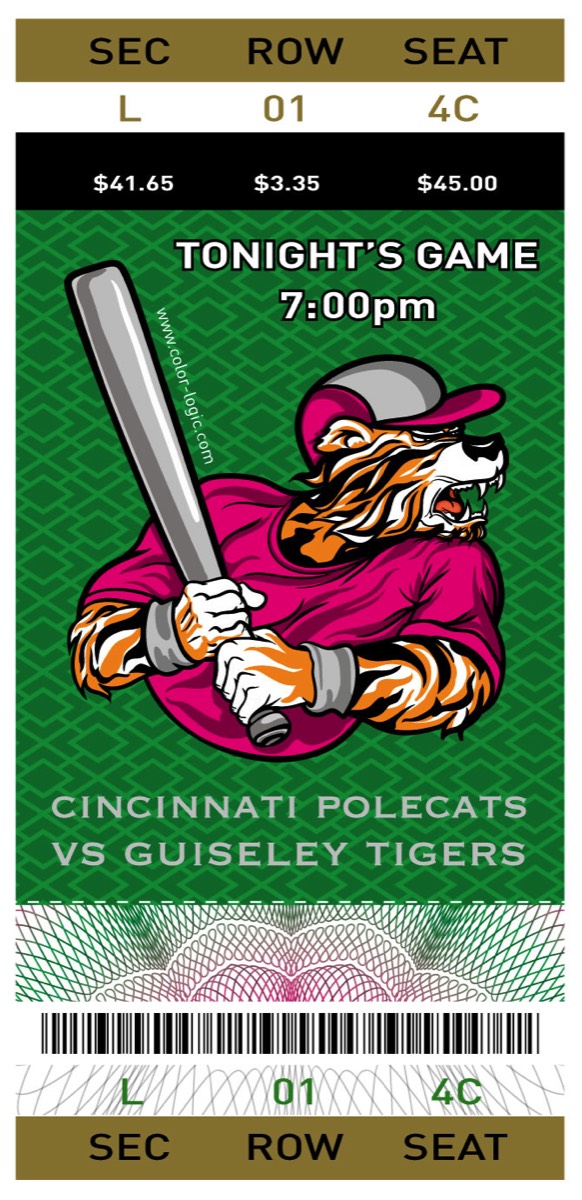
Digital Printing –Variable Data Printing on Colored Foil
When white masks are created manually, it is virtually impossible to incorporate variable data in a foil area to be overprinted CMYK. In such instances, it would be necessary to manually create a separate white ink mask for each data variation.
When the Color-Logic system is used in digital printing processes, variable elements may be used throughout the design. Simple personalized text, as well as more complex techniques such as sequential numbering and variable images are possible. With the Color-Logic software, white ink masks are automatically created as the file is processed, eliminating the need for creating white separations during design.
Color-Logic effects can be used either covertly or overtly to visually embellish a design – The same Color-Logic separation could also be output as an additional security effect separation, using invisible or thermochromatic ink.
Learn more about Variable Data Printing by visiting our dedicated VDP landing page
Combining multiple effects
In the separation visuals shown to the right, the Color-Logic effect plate was output for metallic silver ink printing – An invisible security ink separation was also generated using the same Color-Logic tools.
Without any modifications to the design, the same art file may also be output as a white ink plate for printing on a foil substrate. This technique allows for a design to be output on any device capable of printing either metallic or white inks.
In the separation visuals shown to the right, the Color-Logic effect plate was output for metallic silver ink printing – An invisible security ink separation was also generated using the same Color-Logic tools.
Without any modifications to the design, the same art file may also be output as a white ink plate for printing on a foil substrate. This technique allows for a design to be output on any device capable of printing either metallic or white inks.
